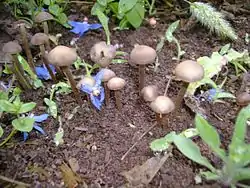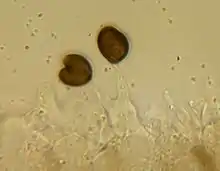Panaeolus bisporus
Panaeolus bisporus, also known as Copelandia bisporus is a rare and widely distributed little brown mushroom that bruises blue and contains the hallucinogen psilocybin.
| Panaeolus bisporus | |
|---|---|
 | |
| Scientific classification | |
| Kingdom: | |
| Division: | |
| Class: | |
| Order: | |
| Family: | |
| Genus: | |
| Species: | P. bisporus |
| Binomial name | |
| Panaeolus bisporus (Malencon and Bertault) Singer and Weeks | |
| Synonyms | |
|
Panaeolus bispora | |
| Panaeolus bisporus | |
|---|---|
float | |
| gills on hymenium | |
| cap is convex | |
| hymenium is adnexed | |
| stipe is bare | |
| spore print is black | |
| ecology is saprotrophic | |
| edibility: psychoactive | |
This mushroom is similar macroscopically to Panaeolus tropicalis, Panaeolus cambodginiensis and Panaeolus cyanescens, but can be differentiated using a microscope by its two spored basidia.
Description

Panaeolus bisporus two spored basidum
This is a little brown mushroom that grows on dung and has black spores. It has been found in Hawaii, Southern California, North Africa, Spain and Switzerland.
See also
References
- Stamets, Paul (1996). Psilocybin Mushrooms of the World. Berkeley: Ten Speed Press. ISBN 0-9610798-0-0.
External links
This article is issued from Wikipedia. The text is licensed under Creative Commons - Attribution - Sharealike. Additional terms may apply for the media files.